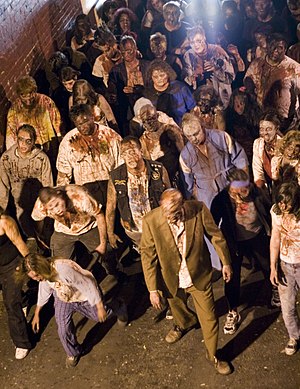
Night of the Living Dead is a 1968 American independent horror film directed, photographed, and edited by George A. Romero, written by Romero and John Russo, produced by Russell Streiner and Karl Hardman, and starring Duane Jones and Judith O'Dea. The story follows seven people trapped in a farmhouse in rural Pennsylvania, under assault by reanimated corpses. Although the flesh-eating monsters that appear in the film are referred to as "ghouls", they are credited with popularizing the modern portrayal of zombies in popular culture.

I Am Legend is a 1954 post-apocalyptic horror novel by American writer Richard Matheson that was influential in the modern development of zombie and vampire literature and in popularizing the concept of a worldwide apocalypse due to disease. The novel was a success and was adapted into the films The Last Man on Earth (1964), The Omega Man (1971), and I Am Legend (2007). It was also an inspiration for George A. Romero's Night of the Living Dead (1968).
Resident Evil, or Biohazard in Japan and parts of Southeast Asia, is a Japanese horror game series and media franchise created by Capcom. It consists of survival horror, third-person shooter and first-person shooter games, with players typically surviving in environments inhabited by zombies and other frightening creatures. The franchise has expanded into other media, including a live-action film series, animated films, television series, comic books, novels, audio dramas and merchandise. Resident Evil is the highest-grossing horror franchise.
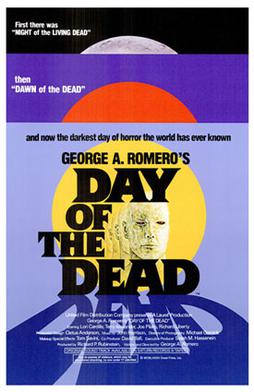
Day of the Dead is a 1985 American post-apocalyptic zombie horror film written and directed by George A. Romero, and produced by Richard P. Rubinstein. The third film in Romero's Night of the Living Dead series, it stars Lori Cardille, Terry Alexander, Joseph Pilato, Jarlath Conroy and Richard Liberty as members of a group of survivors of a zombie apocalypse sheltering in an underground bunker in Florida, where they must determine the outcome of humanity's conflict with the undead horde. Romero described the film as a "tragedy about how a lack of human communication causes chaos and collapse even in this small little pie slice of society".

Apocalyptic and post-apocalyptic fiction is a subgenre of science fiction in which the Earth's civilization is collapsing or has collapsed. The apocalypse event may be climatic, such as runaway climate change; astronomical, such as an impact event; destructive, such as nuclear holocaust or resource depletion; medical, such as a pandemic, whether natural or human-caused; end time, such as the Last Judgment, Second Coming or Ragnarök; or any other scenario in which the outcome is apocalyptic, such as a zombie apocalypse, cybernetic revolt, technological singularity, dysgenics or alien invasion.

Dawn of the Dead is a 1978 zombie horror film written, directed, and edited by George A. Romero, and produced by Richard P. Rubinstein. An American-Italian international co-production, it is the second film in Romero's series of zombie films, and though it contains no characters or settings from the preceding film Night of the Living Dead (1968), it shows the larger-scale effects of a zombie apocalypse on society. In the film, a phenomenon of unidentified origin has caused the reanimation of the dead, who prey on human flesh. David Emge, Ken Foree, Scott Reiniger, and Gaylen Ross star as survivors of the outbreak who barricade themselves inside a suburban shopping mall amid mass hysteria.
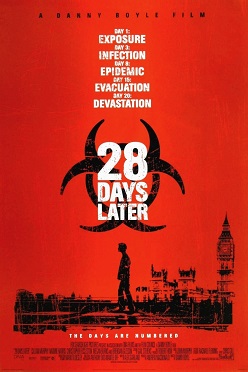
28 Days Later is a 2002 British post-apocalyptic horror film directed by Danny Boyle and written by Alex Garland. It stars Cillian Murphy as a bicycle courier who awakens from a coma to discover the accidental release of a highly contagious, aggression-inducing virus has caused the breakdown of society. Naomie Harris, Christopher Eccleston, Megan Burns, and Brendan Gleeson appear in supporting roles.
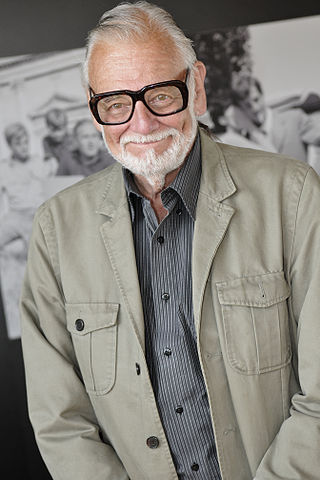
George Andrew Romero Jr. was an American-Canadian film director, writer, editor and actor. His Night of the Living Dead series of films about a zombie apocalypse began with the original Night of the Living Dead (1968) and is considered a major contributor to the image of the zombie in modern culture. Other films in the series include Dawn of the Dead (1978) and Day of the Dead (1985). He later revived his attachment to the sub-genre with Land of the Dead (2005), Diary of the Dead (2007), and Survival of the Dead (2009), his final film. Aside from this series, his works include The Crazies (1973), Martin (1977), Knightriders (1981), Creepshow (1982), Monkey Shines (1988), The Dark Half (1993), and Bruiser (2000). He also created and executive-produced the television series Tales from the Darkside from 1983 to 1988.

Dawn of the Dead is a 2004 action horror film directed by Zack Snyder in his feature directorial debut, with a screenplay by James Gunn. A remake of George A. Romero's 1978 film of the same name, it stars an ensemble cast that includes Sarah Polley, Ving Rhames, Jake Weber, and Mekhi Phifer, with Scott Reiniger, Tom Savini, and Ken Foree from the original film appearing in cameos. Set in Milwaukee, the film follows a group of survivors who try to survive a zombie apocalypse holed up in a suburban shopping mall.

Land of the Dead is a 2005 post-apocalyptic horror film written and directed by George A. Romero; the fourth of Romero's six Living Dead movies, it is preceded by Night of the Living Dead, Dawn of the Dead and Day of the Dead, and succeeded by Diary of the Dead and Survival of the Dead. It was released in 2005, with a budget of $15–19 million, the highest in Romero's Dead series, and has grossed $46 million.
Living Dead, also informally known as Of The Dead is a blanket term for the loosely connected horror franchise that originated from the 1968 film Night of the Living Dead. The film, written by George A. Romero and John A. Russo, primarily focuses on a group of people gathering at a farmhouse to survive from an onslaught of zombies in rural Pennsylvania. It is known to have inspired the modern interpretation of zombies as reanimated human corpses that feast on the flesh and/or brains of the living.

Hell of the Living Dead is a 1980 Italian horror film directed by Bruno Mattei. The film is set in a laboratory in Papua New Guinea that releases a dangerous chemical, turning the technicians and locals into zombies. A French news reporter and her crew land on the island to investigate.
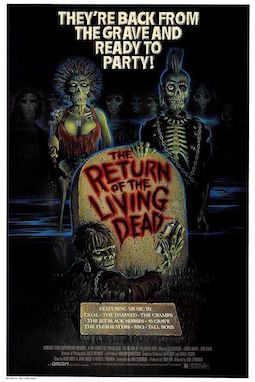
The Return of the Living Dead is a 1985 American comedy horror film written and directed by Dan O'Bannon from a story by Rudy Ricci, John Russo, and Russell Streiner, and starring Clu Gulager, James Karen, Thom Matthews, and Don Calfa. The film tells the story of how a warehouse owner, accompanied by his two employees, mortician friend and a group of teenage punks, deal with the accidental release of a horde of unkillable, brain-hungry zombies onto an unsuspecting town.

Diary of the Dead is a 2007 found footage horror film written and directed by George A. Romero. Although independently produced, it was distributed theatrically by The Weinstein Company and was released in cinemas on February 15, 2008 and on DVD by Dimension Extreme and Genius Products on May 20, 2008.
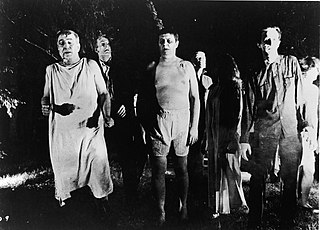
The zombie comedy, often called zom com or zomedy, is a film genre that aims to blend zombie horror motifs with slapstick comedy as well as morbid humor.

A zombie is a mythological undead corporeal revenant created through the reanimation of a corpse. In modern popular culture, zombies are most commonly found in horror and fantasy genre works. The term comes from Haitian folklore, in which a zombie is a dead body reanimated through various methods, most commonly magical practices in religions like Vodou. Modern media depictions of the reanimation of the dead often do not involve magic but rather science fictional methods such as carriers, fungi, radiation, mental diseases, vectors, pathogens, parasites, scientific accidents, etc.

A zombie film is a film genre. Zombies are fictional creatures usually portrayed as reanimated corpses or virally infected human beings. They are commonly portrayed as cannibalistic in nature. While zombie films generally fall into the horror genre, some cross over into other genres, such as action, comedy, science fiction, thriller, or romance. Distinct subgenres have evolved, such as the "zombie comedy" or the "zombie apocalypse". Zombies are distinct from ghosts, ghouls, mummies, Frankenstein's monsters or vampires, so this article does not include films devoted to these types of undead.

World of the Dead: The Zombie Diaries 2 is a 2011 British horror film written by Kevin Gates, directed by Michael Bartlett and Gates and produced by Rob Weston. The film stars Alix Wilton Regan, Philip Brodie and Vicky Aracio. The film is a sequel to The Zombie Diaries.
Night of the Living Dead is a zombie horror media franchise created by George A. Romero beginning with the 1968 film Night of the Living Dead, directed by Romero and cowritten with John A. Russo. The franchise predominantly centers on different groups of people attempting to survive during the outbreak and evolution of a zombie apocalypse. The latest installment of the series, Survival of the Dead, was released in 2009, with a sequel, Twilight of the Dead, in development. This would be the first film in the series not directed by George Romero, who died on July 16, 2017.

